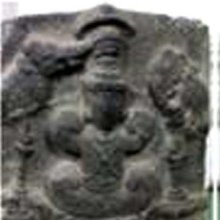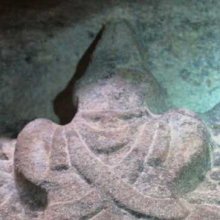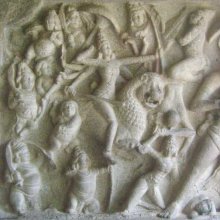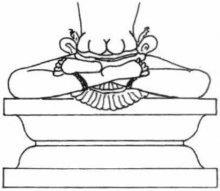Shrivatsa, Śrīvatsa, Śrīvatsā, Shri-vatsa: 33 definitions
Introduction:
Shrivatsa means something in Buddhism, Pali, Hinduism, Sanskrit, Jainism, Prakrit, the history of ancient India, Marathi. If you want to know the exact meaning, history, etymology or English translation of this term then check out the descriptions on this page. Add your comment or reference to a book if you want to contribute to this summary article.
The Sanskrit terms Śrīvatsa and Śrīvatsā can be transliterated into English as Srivatsa or Shrivatsa, using the IAST transliteration scheme (?).
Images (photo gallery)
In Hinduism
Purana and Itihasa (epic history)
Source: Google Books: Cultural History from the Vāyu PurānaŚrīvatsa (श्रीवत्स)—One of the Heavenly ornaments according to the Vāyu Purāṇa. Śrīvatsa is called the lakṣaṇa (distinguishing ornament?) of Viṣṇu.
Source: archive.org: Puranic EncyclopediaŚrīvatsa (श्रीवत्स).—A mole on Mahāviṣṇu’s chest. (For more details see under Bhṛgu).
Source: archive.org: Shiva Purana - English TranslationŚrīvatsa (श्रीवत्स) refers to a particular mark, worn on the chest by Viṣṇu, according to the Śivapurāṇa 2.3.43 (“Description of Śiva’s wonderful sport”).—Accordingly, after Śiva spoke to Viṣṇu and Brahmā: “[...] In the meantime lord Viṣṇu came that way. He looked glorious and splendid, dark-blue like the fresh cloud and having four arms. He had the handsome features of numberless cupids. He wore yellow garments. He was the king of heaven with eyes resembling the petals of a lotus, and looked very calm. He had Garuḍa as his vehicle. He possessed all the characteristic signs conch etc. He was bedecked in crown and other ornaments. He wore Śrīvatsa on his chest (śrīvatsa-vakṣas). He had an uncommon splendour that was incomprehensible. [...]”.
Source: Cologne Digital Sanskrit Dictionaries: The Purana IndexŚrīvatsa (श्रीवत्स).—The jewel of Kṛṣṇa;1 of Pauṇḍarīka Vāsudeva.2

The Purana (पुराण, purāṇas) refers to Sanskrit literature preserving ancient India’s vast cultural history, including historical legends, religious ceremonies, various arts and sciences. The eighteen mahapuranas total over 400,000 shlokas (metrical couplets) and date to at least several centuries BCE.
Pancaratra (worship of Nārāyaṇa)
Source: Wisdom Library: PāñcarātraŚrīvatsa (श्रीवत्स):—One of the nine symbols representing the cosmic principles of the universe, according to the Pāñcarātra literature. These nine weapons and ornaments symbolize the principles which they represent as the presiding deity. The Śrīvatsa symbol represent Prakṛti (‘material world’).
Source: archive.org: Isvara Samhita Vol 5Śrīvatsa (श्रीवत्स) or Śrīvatsamudrā is the name of a mudrā described in the Īśvarasaṃhitā 24.23-24.—Accordingly, “Śrīvatsamudrā is only padmamudrā”. Mūdra (e.g., Śrīvats-amudrā) is so called as it gives joy to the tattvas in the form of karman for those who offer spotless worship, drive out the defects which move about within and without and sealing up of what is done.
Source: SriMatham: Vaiṣṇava Iconology based on Pañcarātra ĀgamaŚrīvatsa (श्रीवत्स):—On Vishnu’s chest there is a small spiral mark (sometimes a small triangle) called Śrīvatsa which means beloved-of-Fortune (Laksmi). This represents Primordial Nature (prakrti)—the First Principle of Manifestation or the material energy which is the source of the natural world. This is the symbol of all that is enjoyed; the multifold beings and forms of the manifested world. The three leaves represent the three gunas or qualiti es of matter—active (rajas), passive (tamas) or balanced (sattva)

Pancaratra (पाञ्चरात्र, pāñcarātra) represents a tradition of Hinduism where Narayana is revered and worshipped. Closeley related to Vaishnavism, the Pancaratra literature includes various Agamas and tantras incorporating many Vaishnava philosophies.
Shilpashastra (iconography)
Source: Google Books: Elements of Hindu iconographyŚrīvatsa (श्रीवत्स) is a mark, a sort of mole, which is conceived to adorn the chest of Viṣṇu in association with the kaustubhamaṇi which is a jewel. In sculpture this mole is represented by a flower of four petals arranged in the form of a rhombus, or by a simple equilateral triangle, and is invariably placed on the right side of the chest.
The Śrīvatsa is peculiar to Viṣṇu. On the chest of Buddha there is the mark known as śrīvatsa; it is perhaps introduced here in the belief that Buddha is an incarnation of Viṣṇu.
Source: Red Zambala: Hindu Icons and Symbols | IntroductionŚrīvatsa (endless knot) - symbolises the way things are = endless and complex — without beginning and end.
Source: Shodhganga: The significance of the mūla-beras (śilpa)Śrīvatsa (mole on the chest of Viṣṇu) refers to one of the several “attributes” (āyudha) or “accessories” of a detiy commonly seen depicted in Hindu iconography, defined according to texts dealing with śilpa (arts and crafs), known as śilpaśāstras.—The śilpa texts have classified the various accessories under the broad heading of āyudha or karuvi (implement), including even flowers, animals, and musical instruments. The other miscellaneous articles found as attributes in the hands of the deities are, for example, Śrīvatsa.
Source: Shodhganga: Vaisnava Agamas And Visnu ImagesŚrīvatsa (श्रीवत्स) refers to a type of special decorative symbol, as defined in treatises such as the Pāñcarātra, Pādmasaṃhitā and Vaikhānasa-āgamas, extensively dealing with the technical features of temple art, iconography and architecture in Vaishnavism.—Another important feature of Viṣṇu is Śrīvatsa, special decorative symbol worn on the chest of Viṣṇu, representing Śrī remaining in the name of Yogalakṣmī. According to Prakīrṇādhikāra (17.56b-59a), he remains in the form of Śrīvatsa on the upper part of the right breast of Viṣṇu who, therefore, known as Śrīvatsavakṣas and Śrīnivāsa. This is the one of the feature differentiates Viṣṇu from the icons of other divinities particularly that of Viśvaksena.

Shilpashastra (शिल्पशास्त्र, śilpaśāstra) represents the ancient Indian science (shastra) of creative arts (shilpa) such as sculpture, iconography and painting. Closely related to Vastushastra (architecture), they often share the same literature.
Vastushastra (architecture)
Source: Wisdom Library: Vāstu-śāstraŚrīvatsa (श्रीवत्स) refers to a type of temple (prāsāda) classified under the group named Lalita, according to Samarāṅgaṇasūtradhāra chapter 56. The Lalita group contains twenty-five out of a sixty-four total prāsādas (temples) classified under four groups in this chapter. The Samarāṅgaṇasūtradhāra is an 11th-century encyclopedia dealing with various topics from the Vāstuśāstra.
Śrīvatsa is also listed in the Agnipurāṇa which features a list of 45 temple types. It is listed under the group named Vairāja, featuring square-shaped temples. This list represents a classification of temples in Nort-India.
Source: Wisdom Library: Vāstu-śāstraŚrīvatsa (श्रीवत्स) refers to a variety of maṇḍapa (halls attached to the temple), according to the Matsya-purāṇa (verses 270.1-30). The śrīvatsa-maṇḍapa is to be built with 48 pillars (stambha). The Matsyapurāṇa is one of the eighteen major purāṇas dating from the 1st-millennium BCE.
Accordingly (verse 270.15-17), “These maṇḍapas (e.g., śrīvatsa) should be either made triangular, circular, octagonal or with 16 sides or they are square. They promote kingdoms, victory, longevity, sons, wife and nourishment respecitvely. Temples of other shape than these are inauspicious.”

Vastushastra (वास्तुशास्त्र, vāstuśāstra) refers to the ancient Indian science (shastra) of architecture (vastu), dealing with topics such architecture, sculpture, town-building, fort building and various other constructions. Vastu also deals with the philosophy of the architectural relation with the cosmic universe.
Shaivism (Shaiva philosophy)
Source: Wisdom Library: ŚaivismŚrīvatsa (श्रीवत्स) refers to one of the “eight lords of divisions” (vigraheśvara) associated with the so-called eight divisions (vigraha) according to the Mataṅgapārameśvara (1.8.83–5). These “eight lords of divisions” are also mentioned in a copper-plate inscription found in Malhar, Chhattisgarh, written around 650 CE. The eight divisions (vigraha) represent the uppermost part of the Lākulas’ impure universe.
All these manifestations of Śiva (e.g., Śrīvatsa) appear at the borders of various divisions of the universe according to the Lākula system.
Source: Shodhganga: Temple management in the ĀgamasŚrīvatsa (श्रीवत्स) refers to one of the eight aṣṭamaṅgala and represents a type of “temple implement (instrument)” as described in the Karaṇalakṣaṇavidhi-paṭala section of the Uttara-Kāmikāgama.—The instruments should be according to the particular śāstra followed at the temple. Some of the instruments mentioned are Śaiva aṣṭamaṅgala including [viz., śrīvatsa].

Shaiva (शैव, śaiva) or Shaivism (śaivism) represents a tradition of Hinduism worshiping Shiva as the supreme being. Closely related to Shaktism, Shaiva literature includes a range of scriptures, including Tantras, while the root of this tradition may be traced back to the ancient Vedas.
Vaishnavism (Vaishava dharma)
Source: Pure Bhakti: Arcana-dipika - 3rd EditionŚrīvatsa (श्रीवत्स) refers to:—A curl of fine golden hair on the upper portion of the right side of lord Viṣṇu’s or kṛṣṇa’s chest. (cf. Glossary page from Arcana-dīpikā).
Source: Pure Bhakti: Brhad BhagavatamrtamŚrīvatsa (श्रीवत्स) refers to:—The emblem of the goddess of fortune, is usually described as a distinct, white hair, on the chest of Śrī Bhāgavan. (cf. Glossary page from Śrī Bṛhad-bhāgavatāmṛta).

Vaishnava (वैष्णव, vaiṣṇava) or vaishnavism (vaiṣṇavism) represents a tradition of Hinduism worshipping Vishnu as the supreme Lord. Similar to the Shaktism and Shaivism traditions, Vaishnavism also developed as an individual movement, famous for its exposition of the dashavatara (‘ten avatars of Vishnu’).
General definition (in Hinduism)
Source: WikiPedia: HinduismThe Shrivatsa is an ancient symbol, considered auspicious in India. Srivatsa means "beloved of Sri", the goddess Lakshmi. It is a mark on the chest of Vishnu where his consort Sri Lakshmi resides. It is said that the tenth avatar of Vishnu, Kalki, will bear the Shrivatsa mark on his chest.
In Buddhism, the Srivatsa is said to be a feature of the tutelary deity (Tibetan: yidam) Manjusri the Youth (Skt: Manjusrikumarabhuta).
Tibetan Buddhists depict the shrivatsa as a triangular swirl or an endless knot.
In Jainism, it often marks the chest of the Tirthankara image. It is one of the ashtamangala (auspicious symbol). It can look somewhat like a fleur-de-lis, an endless knot, a flower or diamond-shaped symbol.
In Buddhism
General definition (in Buddhism)
Source: WikiPedia: BuddhismOne of the Eight Auspicious Symbols
The endless knot (Sanskrit: Shrivatsa); Tibetan: Dpal beu), representing the inter twining of wisdom and compassion; represents the mutual dependence of religious doctrine and secular affairs; represents the union of wisdom and method; the inseparability of emptinesss (Sanskrit: Sunyata) and Dependent Co arrising (Sanskrit: Pratitya samutpada at the time of the path); at the time of enlightenment the union of wisdom (Sanskrit: Prajna) and great compassion (Sanskrit: Karuna); also symbolic of knot symbolism in linking ancestors and omnipresence and the magical ritual and meta process of binding (refer etymology of Tantra, Yoga and religion) (see Namkha), the knot, net and the web metaphor also conveys the Buddhist teaching of the Doctrine of Interpenetration;
In Jainism
General definition (in Jainism)
Source: archive.org: The Jaina Iconography1) Śrīvatsā (श्रीवत्सा) refers to a diagram resembling a flower of four petals arranged at right angles one to another or a curl of hair.
2) Śrīvatsā (श्रीवत्सा) (or Mānavī, Gaurī) is the name of the Yakṣiṇī accompanying Śreyāṃśanātha: the eleventh of twenty-four Tīrthaṃkaras or Jinas, commonly depicted in Jaina iconography.—[...] This eleventh Yakṣiṇī belongs to the eleventh Tīrthaṃkara Śreyāṃśanātha. The Digambara representation of the Yakṣiṇī known therein as Gaurī rides, according to their accounts, anantelope and bears a club, lotus, urn and Varada in her hands. The Śvetāmbara variant of the same Yakṣi in the name of Mānavī or Śrīvatsā Devī has been described as riding a lion and holding a Varada club, urn and goad.
The name Gaurī originates evidently from the Brahmanic Gaurī, the wife of Śiva. Here, in this instance, the Yakṣa, of whom Gaurī is the consort is called Īśvara. Her other aspect is represented by a Vidyādevī, known by the same name. Now, the Śvetāmbaras give her the name of Śrīvatsā or Mānavī. This name, however, presents an anomaly due to the identity of Mānavī with the Digambara Yakṣiṇī, of Śītalanātha bearing the same name. Thus, it is possible to explain the name Śrīvatsā as originating from the Śrīvatsā figure, the canonical symbol of Śītalanātha. As regards the attributes, which adorn the hands of the Devī some of them are war-like, as worthy of a Yakṣiṇī, and others are benign, as symbolic of a goddess of learning.
Source: archive.org: Trisastisalakapurusacaritra1) Śrīvatsa (श्रीवत्स) is the name of Mahendra’s vimāna (celestial car), according to chapter 1.2 [ādīśvara-caritra] of Hemacandra’s 11th century Triṣaṣṭiśalākāpuruṣacaritra: an ancient Sanskrit epic poem narrating the history and legends of sixty-three illustrious persons in Jainism. Accordingly, “[...] Mahendra, accompanied by gods of eight lacs of palaces, came quick as thought in the car Śrīvatsa”.
2) Śrīvatsa (श्रीवत्स) refers to one of the “three auspicious signs” as well as one of the “eight auspicious things” in Jainism, according to the same chapter. Accordingly:
“[...] Then, after circumambulating it, he ascended his aerial car, like his own lofty pride, by the east steps. [...] Then Śakra’s Śāmānikas, like other forms of Śakra, ascended by the north steps and took their proper seats. [...] In front of the Lord of Paulomī (Śakra) seated on the lion-throne shone eight groups of the eight auspicious things, [viz., śrīvatsa], etc. [...]”.
Note: Śrīvatsa, originally a curl of hair, came to be a mark with the general shape of 4 petals, frequently represented enclosed in a rectangular background.
Source: Shodhganga: A cultural study on the jain western Indian illustrated manuscriptsŚrivatsa (श्रिवत्स, “jewel”).—One of the eight providential symbols, or, aṣṭamaṅgala.—Śrivatsa represents the enlightened knowledge that resides in Jineśvara’s heart.

Jainism is an Indian religion of Dharma whose doctrine revolves around harmlessness (ahimsa) towards every living being. The two major branches (Digambara and Svetambara) of Jainism stimulate self-control (or, shramana, ‘self-reliance’) and spiritual development through a path of peace for the soul to progess to the ultimate goal.
India history and geography
Source: Cologne Digital Sanskrit Dictionaries: Indian Epigraphical GlossaryŚrīvatsa.—(SII 2), mole on Viṣṇu's chest; sometimes represented in the shape of a crown as found in the Hathingumpha inscription of Khāravela. Note: śrīvatsa is defined in the “Indian epigraphical glossary” as it can be found on ancient inscriptions commonly written in Sanskrit, Prakrit or Dravidian languages.

The history of India traces the identification of countries, villages, towns and other regions of India, as well as mythology, zoology, royal dynasties, rulers, tribes, local festivities and traditions and regional languages. Ancient India enjoyed religious freedom and encourages the path of Dharma, a concept common to Buddhism, Hinduism, and Jainism.
Languages of India and abroad
Marathi-English dictionary
Source: DDSA: The Molesworth Marathi and English Dictionaryśrīvatsa (श्रीवत्स).—m S A name of viṣṇu. 2 m n also śrīvatsa- lāñcchana n S śrīvatsāṅka m S The mark (a cross-form curl of hair) on the breast of viṣṇu (made by the foot of a Brahman). See ex. under bhramarapaḍaḷī.
Marathi is an Indo-European language having over 70 million native speakers people in (predominantly) Maharashtra India. Marathi, like many other Indo-Aryan languages, evolved from early forms of Prakrit, which itself is a subset of Sanskrit, one of the most ancient languages of the world.
Sanskrit dictionary
Source: DDSA: The practical Sanskrit-English dictionaryŚrīvatsa (श्रीवत्स).—
1) an epithet of Viṣṇu.
2) a mark or curl of hair on the breast of Viṣṇu; प्रभानुलिप्त- श्रीवत्सं लक्ष्मीविभ्रमदर्पणम् (prabhānulipta- śrīvatsaṃ lakṣmīvibhramadarpaṇam) R.1.1.
3) a hole in a wall made by a house-breaker. °अङ्कः, °धारिन्, °मृत्, °लक्ष्मन्, °लाञ्छन (aṅkaḥ, °dhārin, °mṛt, °lakṣman, °lāñchana) m. epithets of Viṣṇu; तमभ्यगच्छत् प्रथमो विधाता श्रीवत्सलक्ष्मा पुरुषश्च साक्षात् (tamabhyagacchat prathamo vidhātā śrīvatsalakṣmā puruṣaśca sākṣāt) Kumārasambhava 7.43.
Derivable forms: śrīvatsaḥ (श्रीवत्सः).
Śrīvatsa is a Sanskrit compound consisting of the terms śrī and vatsa (वत्स).
Source: Cologne Digital Sanskrit Dictionaries: Shabda-Sagara Sanskrit-English DictionaryŚrīvatsa (श्रीवत्स).—m.
(-tsaḥ) 1. Vishnu. 2. A particular mark, usually said to be a curl of hair, on the breast of Vishnu or Krishna. 3. A hole in a wall made for felonious purposes. 4. The emblem of the tenth Jina, or the mark above ascribed to Vishnu or Krishna. E. śrī Lakshmi, and vatsa dear to.
Source: Cologne Digital Sanskrit Dictionaries: Benfey Sanskrit-English DictionaryŚrīvatsa (श्रीवत्स).—m. 1. Viṣṇu. 2. a mark, usually said to be a curl of hair on the breast of Viṣṇu or Kṛṣṇa, represented by , [Johnson's Selections from the Mahābhārata.] 96, 74. 3. a hole in a wall for felonious purposes.
— Cf. vatsatara.
Śrīvatsa is a Sanskrit compound consisting of the terms śrī and vatsa (वत्स).
Source: Cologne Digital Sanskrit Dictionaries: Cappeller Sanskrit-English DictionaryŚrīvatsa (श्रीवत्स).—[masculine] a curl of hair of a cert. form on the breast of Viṣṇu.
Source: Cologne Digital Sanskrit Dictionaries: Aufrecht Catalogus Catalogorum1) Śrīvatsa (श्रीवत्स) as mentioned in Aufrecht’s Catalogus Catalogorum:—a poet, contemporary of Maṅkha. Śrīkaṇṭhacarita 25, 82.
2) Śrīvatsa (श्रीवत्स):—son of Narasiṃha: Naiṣadhīyacaritaṭīkā.
Source: Cologne Digital Sanskrit Dictionaries: Monier-Williams Sanskrit-English Dictionary1) Śrīvatsa (श्रीवत्स):—[=śrī-vatsa] [from śrī] m. ‘favourite of Śrī’ Name of Viṣṇu, [cf. Lexicographers, esp. such as amarasiṃha, halāyudha, hemacandra, etc.]
2) [v.s. ...] a [particular] mark or curl of hair on the breast of Viṣṇu or Kṛṣṇa (and of other divine beings; said to be white and represented in pictures by a symbol resembling a cruciform flower), [Mahābhārata; Kāvya literature] etc.
3) [v.s. ...] the emblem of the tenth Jina (or Viṣṇu’s mark so used), [cf. Lexicographers, esp. such as amarasiṃha, halāyudha, hemacandra, etc.]
4) [v.s. ...] a hole of a [particular] form made through a wall by a housebreaker, [cf. Lexicographers, esp. such as amarasiṃha, halāyudha, hemacandra, etc.]
5) [v.s. ...] (in [astronomy]) one of the lunar asterisms, [Colebrooke]
6) [v.s. ...] Name of the eighth Yoga, [Monier-Williams’ Sanskrit-English Dictionary]
7) [v.s. ...] Name of various authors (also with ācārya and śarman), [Catalogue(s)]
Source: Cologne Digital Sanskrit Dictionaries: Yates Sanskrit-English DictionaryŚrīvatsa (श्रीवत्स):—[śrī-vatsa] (tsaḥ) 1. m. Vishnu or his mark (said to be a curl of hair peculiarly shaped;) hole for stealing.
[Sanskrit to German]
Sanskrit, also spelled संस्कृतम् (saṃskṛtam), is an ancient language of India commonly seen as the grandmother of the Indo-European language family (even English!). Closely allied with Prakrit and Pali, Sanskrit is more exhaustive in both grammar and terms and has the most extensive collection of literature in the world, greatly surpassing its sister-languages Greek and Latin.
Kannada-English dictionary
Source: Alar: Kannada-English corpusŚrīvatsa (ಶ್ರೀವತ್ಸ):—
1) [noun] Viṣṇu.
2) [noun] a particular mark or curl of hair on the breast of Viṣṇu.
Kannada is a Dravidian language (as opposed to the Indo-European language family) mainly spoken in the southwestern region of India.
See also (Relevant definitions)
Starts with: Shrivatsa acarya, Shrivatsa sharman, Shrivatsa shrinivasa acarya, Shrivatsa vyasa, Shrivatsabhrit, Shrivatsadharin, Shrivatsaki, Shrivatsakin, Shrivatsalanchana, Shrivatsalanchhana, Shrivatsamudra, Shrivatsamuktikanandyavartalakshitapanipadatala, Shrivatsamuktikanandyavartalakshitapanipadatalata, Shrivatsanka, Shrivatsanka mishra, Shrivatsapinyaka, Shrivatsasvastikanandyavartalalitapanipada, Shrivatsavakshas, Shrivatsavihara.
Ends with: Hridayashrivatsa.
Full-text (+59): Shrivatsalanchana, Shrivatsanka, Shrivatsabhrit, Shrivatsakin, Shrivatsamuktikanandyavartalakshitapanipadatalata, Shrivatsadharin, Shrivatsapinyaka, Shrivaccha, Shrivrikshaka, Ashtamangala, Siddhantaratnamala, Shrivatsa vyasa, Shrivatsa sharman, Shrivatsa shrinivasa acarya, Shrivatsa acarya, Vatsanka, Bhramarapadala, Shitalanatha, Ashtamangalika, Cidgaganacandrika.
Relevant text
Search found 69 books and stories containing Shrivatsa, Śrī-vatsa, Śrīvatsa, Sri-vatsa, Śrīvatsā, Shri-vatsa, Srivatsa, Śrī-vatsā; (plurals include: Shrivatsas, vatsas, Śrīvatsas, Śrīvatsās, Srivatsas, vatsās). You can also click to the full overview containing English textual excerpts. Below are direct links for the most relevant articles:
Garga Samhita (English) (by Danavir Goswami)
Verse 2.7.26 < [Chapter 7 - Kidnapping of the Calves and Cowherd Boys]
Verse 1.2.56 < [Chapter 2 - Description of the Abode of Śrī Goloka]
Verse 2.9.25 < [Chapter 9 - Brahmā’s Prayers]
Tiruvaymoli (Thiruvaimozhi): English translation (by S. Satyamurthi Ayyangar)
Pasuram 3.4.3 < [Section 4 - Fourth Tiruvaymoli (Pukalum nal oruvan)]
Pasuram 5.2.8 < [Section 2 - Second Tiruvaymoli (Polika Polika)]
Cidgaganacandrika (study) (by S. Mahalakshmi)
Verse 312 [Kālidasa’s Cidgaganacandrikā benefits entire mankind] < [Chapter 4 - Fourth Vimarśa]
Shat-cakra-nirupana (the six bodily centres) (by Arthur Avalon)
Jainism in Odisha (Orissa) (by Ashis Ranjan Sahoo)
Jaina Antiquities at Udayagiri Hills (Khordha) < [Chapter 3: Survey of Jaina Antiquities in Odisha]
Jain symbols in Art < [Chapter 5]
Jaina Antiquities at Khandagiri Hills (Khordha) < [Chapter 3: Survey of Jaina Antiquities in Odisha]



